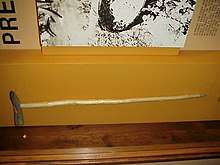Digging stick
In archaeology and anthropology, a digging stick, or sometimes yam stick, is a wooden implement used primarily by subsistence-based cultures to dig out underground food such as roots and tubers or burrowing animals and anthills.[1] The stick may also have other uses in hunting or general domestic tasks.

They are common to the Indigenous Australians but also other peoples worldwide. The tool normally consists of little more than a sturdy stick which has been shaped or sharpened and sometimes hardened by being placed temporarily in a fire. Fashioned with handles for pulling or pushing, it forms a prehistoric plow, and is also a precursor of most modern agricultural handtools.[2]
By region
Mexico and the Mesoamerican region
In Mexico and the Mesoamerican region, the digging stick was the most important agricultural tool throughout the region.[3][4]
The coa stick normally flares out into a triangle at the end and is used for cultivating maize. It is still used for agriculture in some indigenous communities, with some newer 20th-century versions having the addition of a little metal tip.
Other digging sticks, according to Native Americans of the Columbia Plateau, have been used since time immemorial to gather edible roots like balsamroot, bitterroot, camas, and varieties of biscuitroot. Typical digging sticks were and are still about 2 to 3 feet in length, usually slightly arched, with the bottom tip shaved off at an angle. A 5 to 8 inch cross-piece made of antler, bone, or wood was fitted perpendicularly over the top of the stick, allowing the use of two hands to drive the tool into the ground. Since contact with the Europeans in the 19th century, Native Americans have also adapted the use of a metal in making digging sticks.
Ethiopia and the Harar region
The most common digging stick found in Ethiopia is the ankassay in Amharic, a Semitic language spoken in Ethiopia and the second-most spoken Semitic language in the world. The ankassay is a single shaft that is about 4–5 feet in length with a socket-hafted pointed iron blade as the tip.[5]
Two other digging sticks are unique to the Harar region located in East-Central Ethiopia, which are considered to be unusual due to their function beyond the basic use of other digging sticks, and the use of one as a plow.
The deungora is a particularly long digging stick is about 110 centimeters, or approximately 3.6 feet, in length with a socket-hafted pointed iron blade as the tip. What's unique about this digging stick is that a bored stone, about 15 centimeters in diameter, is attached at the opposing end. This stone shares the same form as other bored stones that have been discovered in archaeological sites in Africa.[5]
Maresha is the Gurage name, also the same word used by the Amhara, for a digging stick that differs in construction because of its forked form. It is used primarily to dig holes for construction, planting, and harvesting roots and tubers. This tool is used as a plow to turn over the soil of an entire field before planting. It is used to break clods of soil in areas where the soil is hard or in areas that may be too steep for plowing, and to dig holes for construction or to transplant domestic plants. When compared to the ankassay, this digging stick can perform the same duties and in addition can be used as a hoe.[5]
East-Central New Guinea
The Kuman people of this region were horticulturists who used basic tools such as the digging stick, wooden hoe, and wooden spade in their daily lives. Eventually they started to use more sophisticated tools such as iron spades and pick-axes.[6]
Two main types of digging sticks both shared a similar shape but differed in size:
- A larger and heavier digging stick with a diameter of about 4 centimeters and 2 meters in length, used for the purpose of turning over the soil surface for new gardens
- A smaller and lighter digging stick with a diameter of about 2 centimeters and 1 meter (or less) in length, mainly used for basic horticulture tasks[6]
References
- The American Heritage Dictionary of the English Language, Fourth Edition. Retrieved July 24, 2008
- Encyclopædia Britannica, Inc. Retrieved March 26, 2015, from Britannica.com website: http://www.britannica.com/EBchecked/topic/163245/digging-stick
- Study the Digging Stick Mexicolore.
- Uictli Mexicolore.
- Simoons, Frederick J. "The Forked Digging Stick of the Gurage", "Zeitschrift für Ethnologie", Berlin, Retrieved February 27, 2015.
- Nilles, John. "The Kuman people: A study of cultural change in a primitive society in the Central Highlands of New Guinea." Oceania (1953): 1-27.
External links
